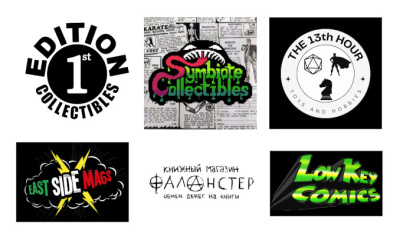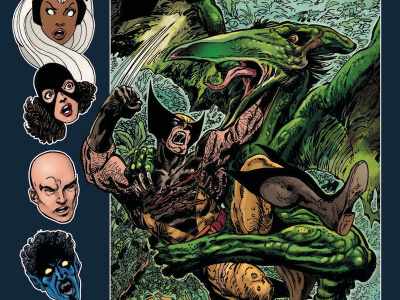 ICv2 interviewed DC co-publishers Jim Lee and Dan Didio at Comic-Con in our annual conversation about the state of the market and DC’s place in it. In Part 1, we talk about the market, the impact of variant covers, finding new customers, the Orson Scott Card Superman story, and Before Watchmen. In Part 2, we talked about the battles over editorial control of storytelling, DC’s fit for the bookstore audience, the impact of the management changes at Warner Bros., and their top expectations in the next six to 12 months.
ICv2 interviewed DC co-publishers Jim Lee and Dan Didio at Comic-Con in our annual conversation about the state of the market and DC’s place in it. In Part 1, we talk about the market, the impact of variant covers, finding new customers, the Orson Scott Card Superman story, and Before Watchmen. In Part 2, we talked about the battles over editorial control of storytelling, DC’s fit for the bookstore audience, the impact of the management changes at Warner Bros., and their top expectations in the next six to 12 months.What are you seeing in terms of the overall market conditions and what the consumer market is like now?
Didio: We still see a resurgence of comics in general. We see a lot of growth in what’s going on. We show an increase in business on both the print and digital side, which I think’s important to say, because neither is cannibalizing and they seem to be complementing each other very nicely and growing the business overall.
It’s interesting to us to watch as the other companies are being very aggressive in a good way, and I think it builds a very strong competitive market and makes sure we’re on the best of our game.
Lee: We’re still riding the positive momentum generated by The New 52. If you look at the overall business within the physical channel, it was fairly stagnant for a while, and then with The New 52 in September of 2011 you start seeing a rapid rise in sales, and then across all the different companies. So obviously we’re bringing in new readers, a lot of lapsed readers, and everyone’s been seeing a positive return on that.
And, alluding to what Dan was saying, I think we’re at about double-digit growth on the print side and about triple-digit growth on the digital side, which is probably what everyone else is experiencing.
It’s really positive. Right now retailers are flush with capital, and they are reinvesting it in new projects so you’re seeing ever increasing orders for new releases and new initiatives. It’s not speculator-driven, like it was back in the 90s, so I think it’s really positive for the future.
You mentioned that the market is not speculator-driven, but there is a pretty heavy component of variant covers in the market. Do you think we’re at the danger point?
Didio: I’m always concerned about variant covers, primarily because if retailers are purchasing a hundred books to get one cover that they’re going to be able to sell online or somewhere else, and those hundred books don’t go on sale or aren’t sold to anybody else, it’s just limiting the number of people that are actually reading our material. Our goal is to put books in people’s hands that are reading the comics. That’s one of the reasons why when we do the 3-D motion covers in September, we’re actually making that the primary cover because it’s important for us that if people are excited by stunts like that that they actually get the book to read and make it available to themselves.
We’re also in the process of evaluating our own variant program. We see some slowing on the lower end books where the variants don’t seem to be helping. We’re trying to find a way that if we are doing variants, it is to really sell more product.
Lee: As a general category, variants don’t move the needle that much. In fact, the numbers are pretty dismal. It’s only when you do something special with a variant, whether it’s something clever like the 50 flags of the United States, or what we did with the throwback designs from Superman Unchained where we had a different Superman cover based on every era of the seven and a half decades that he’s been published, or if you look at the three motion covers that we’re doing for villain’s month--all unique propositions--that you do see a reaction from the marketplace because it’s a great way of promoting what you’re doing. There is real appetite among the core readers for that kind of variant, but you’re not seeing a lot of movement if you just slap your common, everyday variant on a book. It’s not like the days in the 90s where that was a speculative order and people were trying to flip it before the books even hit the shelves.
The books seem to be falling into the hands of collectors and it ends with one generation of collectors; you’re not seeing them on the secondary market over and over again.
So the lack of quick resale is one of the reasons you think we’re not at a danger point yet?
Lee: Exactly.
The environment for acquiring new customers has changed a lot in the last few years; we’ve lost all those Borders stores, digital is in play now, and you’re involved in the videogame space. Where are new customers coming from, and what is DC doing to bring them into the comic store fold?
Lee: The digital side has been a real boon for us. Our strategy has been not to convert our print buyers into digital buyers so we haven’t done digital comics that tie into the core New 52 franchises. All the stuff we’ve been doing digitally has either tied into the mass market, popular franchises like the Arkham Asylum games or popular TV shows like Smallville.
To clarify: You’re talking about your digital first titles?
Lee: Yes. What we’re finding is anywhere from 30-40% of those readers are first-time digital purchasers, or are even new to comics in general. We know we’re definitely reaching a new audience. The stuff we’re planning on doing with DC Squared and DC Squared Multiverse is designed to tap into the videogame marketplace. That’s an adjacent group of fans who obviously know who are characters are but aren’t necessarily reading comics on a regular basis. To me, that’s the lowest hanging fruit, so we have very aggressive plans to keep looking towards that.
With the advent of the iPad and all the tablet devices, we now have a little comic book shop in everyone’s home. It’s been the Holy Grail of the industry for many decades: how do we find new readers? Now we finally have the opportunity, now we just have to figure out the price point, the type of content, the frequency at which they want it. We’re constantly exploring and experimenting with all those factors.
Are you doing anything in the videogames themselves to direct people to comics?
Lee: We do, if you look at Injustice: Gods Among Us, which was hugely successful, and then the games coming up called Infinite Crisis and Batman Arkham Origins. We work very closely with Warner Brothers Games to develop either prequel or interstitial comic content. If you follow the videogame space, there’s so much pressure to deliver incredible gameplay that they don’t necessarily have the time or resources to tell the whole story they need to make it a full experience, and that’s where we’ve been stepping in and helping flesh that out. To give you a prime example, Infinite Crisis comes out later this fall. It’s essentially a multiverse of DC characters where Gotham by Gaslight Batman might run into a nightmare or vampire Batman from Batman Red Rain. There are different Elseworlds versions of the character, so we’re going to go back in and re-explore that world and publish all of those characters in all these different iterations to allow of these new people who are not familiar with all these different versions of Batman to have a chance to explore all of these individual worlds by buying digital content.
You announced that Adventures of Superman with an Orson Scott Card and Aaron Johnston story got pulled back because the artist dropped out. What’s going on with that?
Lee: We’re searching for an artist to work on that story so it’s been tabled until that happens.
Didio: We have a number of projects that started at the same time, so it moved back in the queue and we have other ones that are further along in production that we’re moving with first.
But not cancelled, you’re still going to do it?
Didio: Yes.
The first Before Watchmen trades are coming out. Did the periodical side meet your expectations?
Didio: Absolutely. Realistically, when we went out there we had a certain expectation and it exceeded those expectations when it first launched. They maintained strong numbers all the way through. We had a little slippage at the end when the schedule started to slip, but for the most part, everything did better than expected. We couldn’t be more excited about how the first two books are charting with The New York Times bestsellers list being #1 And #2 as they were first released.
Click here for Part 2.







